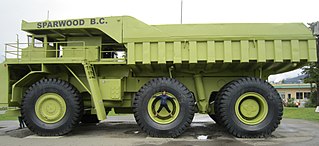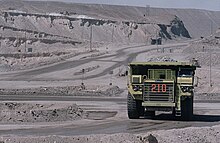
Excavators are heavy construction equipment primarily consisting of a boom, dipper, bucket and cab on a rotating platform known as the "house" - although the largest form ever, the dragline excavator, eliminated the dipper in favor of a line and winch.

A bulldozer or dozer is a large, motorized machine equipped with a metal blade to the front for pushing material: soil, sand, snow, rubble, or rock during construction work. It travels most commonly on continuous tracks, though specialized models riding on large off-road tires are also produced. Its most popular accessory is a ripper, a large hook-like device mounted singly or in multiples in the rear to loosen dense materials.

A loader is a heavy equipment machine used in construction to move or load materials such as soil, rock, sand, demolition debris, etc. into or onto another type of machinery.

Heavy equipment, heavy machinery, earthmovers, construction vehicles, or construction equipment, refers to heavy-duty vehicles specially designed to execute construction tasks, most frequently involving earthwork operations or other large construction tasks. Heavy equipment usually comprises five equipment systems: the implement, traction, structure, power train, and control/information.

A grader, also commonly referred to as a road grader, motor grader, or simply blade, is a form of heavy equipment with a long blade used to create a flat surface during grading. Although the earliest models were towed behind horses, and later tractors, most modern graders are self-propelled and thus technically "motor graders".

Volvo Construction Equipment - Volvo CE - is a major international company which develops, manufactures, and markets equipment for construction and related industries. It is a subsidiary and business of the Volvo Group.

A dump truck, known also as a dumping truck, dump trailer, dumper trailer, dump lorry or dumper lorry or a dumper for short, is used for transporting materials for construction as well as coal. A typical dump truck is equipped with an open-box bed, which is hinged at the rear and equipped with hydraulic rams to lift the front, allowing the material in the bed to be deposited ("dumped") on the ground behind the truck at the site of delivery. In the UK, Australia, South Africa and India the term applies to off-road construction plants only and the road vehicle is known as a tip lorry, tipper lorry, tipper truck, tip truck, tip trailer or tipper trailer or simply a tipper.

A dumper or dumper truck or dump truck is a truck designed for carrying bulk material, often on building sites. A dumper has a body which tilts or opens at the back for unloading and is usually an open 4-wheeled vehicle with the load skip in front of the driver. The skip can tip to dump the load; this is where the name "dumper" comes from. They are normally diesel powered. A towing eye is fitted for secondary use as a site tractor. Dumpers with rubber tracks are used in special circumstances and provide a more even distribution of weight compared to tires. Continuous tracks allow the operator to carry heavier payload on slick, snowy, or muddy surfaces, and are popular in some countries. Rubber track dumpers offer even weight distribution for transporting heavy payloads over challenging terrains like mud or snow, popular in certain regions. Roll Off Dumpsters, contrastingly, are large, stationary containers designed for substantial waste management, easily loaded and transported by specialized trucks.
Robert Gilmour LeTourneau, born in Richford, Vermont, was a prolific inventor of earthmoving machinery, and founder of LeTourneau Technologies, Inc and LeTourneau University. His factories supplied machinery which represented nearly 70 percent of the earthmoving equipment and engineering vehicles used by the Allied forces during World War II, and more than half of the 1,500-mile (2,414 km) Alcan Highway in Canada was built with LeTourneau equipment. Over the course of his life he secured nearly 300 patents relating to earthmoving equipment, manufacturing processes and machine tools.

In civil engineering, a wheel tractor-scraper is a type of heavy equipment used for earthmoving. It has a pan/hopper for loading and carrying material. The pan has a tapered horizontal front cutting edge that cuts into the soil like a carpenter's plane or cheese slicer and fills the hopper which has a movable ejection system. The horsepower of the machine, depth of the cut, type of material, and slope of the cut area affect how quickly the pan is filled.

The Autocar Company is an American specialist manufacturer of severe-duty, Class 7 and Class 8 vocational trucks, with its headquarters in Birmingham, Alabama. Started in 1897 in Pittsburgh, Pennsylvania, as a manufacturer of Brass Era automobiles, and trucks from 1899, Autocar is the oldest surviving motor vehicle brand in the Western Hemisphere.

Hitachi Construction Machinery (Europe) NV (HCME) is a subsidiary of Hitachi Construction Machinery Co., Ltd. (HCM) and was established in 1972 in Oosterhout, The Netherlands. It is responsible for the manufacture, sales and marketing of Hitachi construction equipment throughout Europe, Africa and the Middle East.
Terex Corporation is an American company and worldwide manufacturer of lifting and material-handling equipment. Products include those that enable customers to reduce their impact on the environment including electric and hybrid offerings, deliver emission-free performance, support renewable energy, and aid in the recovery of reusable materials from waste. Terex does business in the Americas, Europe, Australia and Asia Pacific.

An articulated hauler, articulated dump truck (ADT), or sometimes a dump hauler, is a very large heavy-duty type of dump truck used to transport loads over rough terrain, and occasionally on public roads. The vehicle usually has all-wheel drive and consists of two basic units: the front section, generally called the tractor, and the rear section that contains the dump body, called the hauler or trailer section. Steering is made by pivoting the front in relation to the back by hydraulic rams. This way, all wheels follow the same path, making it an excellent off-road vehicle.

Haul trucks are off-road, heavy-duty dump trucks specifically engineered for use in high-production mining and exceptionally demanding construction environments. Most are dual axle; at least two examples of tri-axles were made in the 1970s. Haul trucks are denominated by their payload capacity, by weight.

The Terex 33-19 "Titan" was a prototype off-highway, ultra class, rigid frame, three-axle, diesel/AC electric powertrain haul truck designed by the Terex Division of General Motors and assembled at General Motors Diesel Division's London, ON, Canada assembly plant in 1973. Only one 33-19 was ever produced and it was the largest, highest capacity haul truck in the world for 25 years. After 13 years in service, the 33-19 was restored and is now preserved on static display as a tourist attraction in Sparwood, BC, Canada.

Fiatallis, was a brand of heavy equipment, such as loaders, bulldozers, backhoes, scrapers, and graders. It began in January 1974, when Allis-Chalmers's construction equipment business was reorganized into a joint venture with Fiat SpA, which bought a 65% majority stake at the outset.

The Volvo VN is a heavy-duty truck produced by the Swedish vehicle manufacturer Volvo Trucks. Initially developed in North America, it was introduced in 1996 as the second generation Volvo Class 8 tractor. For the 2004 model year the third generation model was introduced with a revised hood, headlamps, fairings and interior, and the VN was officially renamed VNL. Other models included the VNM and the VNR.
The Payhauler is a series of dump trucks that were produced from 1956 to 2003. Introduced by International Harvester as the International Harvester Payhauler, the line was spun off in 1982 into a separate company, the Payhauler Corporation.

Belarus had third by volume part of automotive industry of the Soviet Union with near 40,000 annual production. Since that times Belarus specializes on production of own designed superheavy, heavy and middle trucks mainly plus post-Soviet developed buses, trolleybuses and trams. Auto manufacturers in Belarus include MAZ, BelAZ and Neman.





















